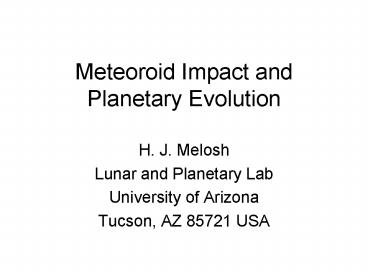Meteoroid Impact and Planetary Evolution PowerPoint PPT Presentation
1 / 50
Title: Meteoroid Impact and Planetary Evolution
1
Meteoroid Impact and Planetary Evolution
- H. J. Melosh
- Lunar and Planetary Lab
- University of Arizona
- Tucson, AZ 85721 USA
2
The study of impact craters has a well-defined
beginning 1610
3
Galileos small telescope and limited field of
view did not permit him to view the entire moon
at once, so his global maps were distorted
- Nevertheless, he recognized a pervasive landform
that he termed spots - He described them as circular, rimmed depressions
- But declined to speculate on their origin
4
Robert Hooke had a better telescope in 1665
- Hooke make good drawings of Hipparchus and
speculated on the origin of the lunar pits. He
considered impact, but dismissed it because he
could not imagine a source for the impactors. In
the end, he opted for a volcanic origin. - For the next 300 years astronomers accepted this
origin.
5
In 1893 American Geologist G. K. Gilbert proposed
an impact origin for lunar craters
6
Gilbert established a size-morphology progression
for craters
- Small craters are simple bowls
- Larger craters have central peaks and wreaths of
terraces - Craters are of different ages Some are fresh,
others old and degraded
7
The first impact crater recognized on Earth was
the Arizona Meteor crater
8
- D. M. Barringer established a meteoritic origin
in 1906, but until the end of his life he
believed that the iron meteorite that created the
crater was buried beneath its floor
9
Impact-Explosion Analogy
- In the early 20th century, a number of workers
realized that a high-speed impact resembled an
explosion. Öpik (1916), Ives (1919), Moulton
(1929) and Gifford (1924) all promoted this idea.
Giffords arguments eventually carried the day.
10
Crypto-Volcanic Structures
- Geologists Boone and Albritton re-interpreted
Crypto-Volcanic structures as impacts in 1937
and defined the geologic characteristics of
impact craters
11
In 1964 Robert Dietz proposed the first
shock-metamorphic feature diagnostic of impact
Shatter Cones
12
High pressure polymorphs and shock features in
quartz followed quickly
13
Modern Size-Morphology Progression
- Simple, bowl-shaped craters. Less than 15 km
diameter on the moon - Complex craters with central peaks and terraced
rims. From 30 to 200 km diameter on the moon
14
The simple-complex transition is accompanied by a
sudden decrease in crater depth
15
- Peak-ring craters. About 300 km diameter on the
moon - Multi-ring basins. Largest sizes, more than 500
km diameter on the moon
16
Another type of Multi-ring structure on Callisto
and Europa
17
Studies of cratering were advanced by three areas
of research
- Nuclear weapons effects,
18
Numerical simulations of impacts and explosions,
19
and experimental studies of the impact process
20
Crater MechanicsContact and Compression
21
The shock wave accelerates material that will
eventually open into a crater
22
Streamlines cut across shock contours
23
It is important to understand where materials
originate--the depth of excavation does not equal
the depth of the crater!
24
Impact melt volume scales as a function of crater
size
25
Excavation follows a simple progression from
hemispherical to parabolic
26
Don Gaults 1968 view of this process
27
Simple crater excavation and collapse
28
Complex crater excavation and collapse
29
(No Transcript)
30
Impact craters on Earth are sparse
31
But may be of considerable local and economic
importance
- Elgygytgyn, Siberia Vredefort, South
Africa
32
On other plants, craters are often the dominant
landform
33
The population of impact craters reaches an
equilibrium
34
The degradation pattern depends on the slope of
the size-frequency relation
35
Impacts have brought us rocks from Mars and the
Moon
36
1.25 mm wide, Xpolar
37
The process of spallation is responsible for
ejecting material at high speed but low shock
pressure
38
The interaction of the stress wave with the free
surface leads to a characteristic pattern of
fractures
39
An impact caused the greatest biological
extinction in the last 100 Million years
40
- Global wildfires, sun-obscuring aerosols, acid
rain, ozone loss, etc, etc, killed half the
animal families alive before the impact
41
But left tangible evidence in the form of a
global, Ir-rich spherule layer,
42
The high-speed ejecta was dispersed ballistically
43
Reentry of the ejecta caused immediate wildfires
44
As well as a large impact crater--Chicxulub
45
Early in Earths history, a gigantic collision
with a Mars-size protoplanet may have created the
Moon
46
But this is only the tail end of a much bigger
story
- The Earth and planets grew out of a large swarm
of smaller planetesimals. As growth continued,
a hierarchical spectrum of planetary bodies
resulted
The present-day distribution of asteroid sizes
reflects the same distribution
47
The resulting D-2 distribution has special
properties
48
- Thus, while the smaller bodies may be much more
numerous than the larger ones, most of the mass
and energy is contributed by the largest impacts - This is the definition of a Catastrophe The
largest impacts produce more geologic change than
all of the small ones combined
49
- The final stages of planetary growth were
characterized by extreme violence, with global
melting episodes followed by periods of cooling.
This may have happened dozens of times in Earth
history.
50
The surfaces, and indeed the very existence, of
the Earth, Moon and the rest of the solar system
is affected by the impact of solid objects

